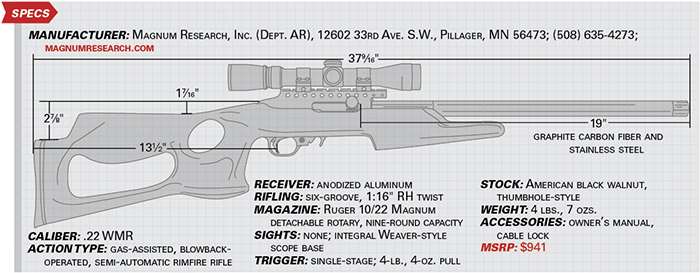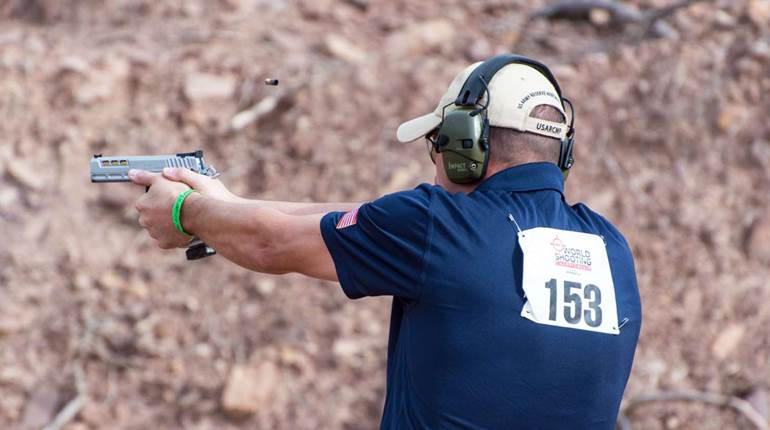
Shortly after Sturm, Ruger & Co.’s 1999 introduction of its .22 WMR-chambered Model 10/22 Magnum, Magnum Research, Inc., rolled out its U.S.-made Magnum Lite Rifle (MLR) in the same chambering. Ironically, when production of the Model 10/22 Magnum ceased in 2006, the MLR not only began filling the former’s niche, but, according to the Blue Book of Gun Values, Thirty-Fourth Edition, the 10/22 Magnum’s receiver was also used in the manufacture of some MLRs. Since that time, the .22 WMR MLR has been offered in an array of configurations, with the most recent being the Magnum Lite Rifle .22 WMR Barracuda American Black Walnut (MLR22WMBW) variant reviewed here.
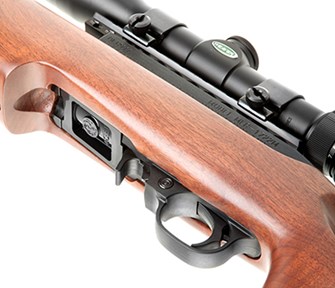 The rifle’s foundation is a CNC-machined, anodized-aluminum receiver measuring 6 ¾" in length and 1 ¼" wide. A 1 1⁄8" extension at its front serves as the attachment point for the steel V-block that secures the barrel via two screws. Integral to the receiver is a 6 3⁄16"-long rail that accepts Weaver-style scope rings. A series of holes and scalloping on the rail enhance the rifle’s aesthetics. Overall, the machining of the receiver was consistent and featured few tooling marks, however, there were two exceptions. At the rear of the rail there was unevenness, and internally the left receiver wall had several deep, unsightly gouges. Safety wouldn’t be compromised but, for a rifle approaching $1,000 in price, we expected more attention to detail.
The rifle’s foundation is a CNC-machined, anodized-aluminum receiver measuring 6 ¾" in length and 1 ¼" wide. A 1 1⁄8" extension at its front serves as the attachment point for the steel V-block that secures the barrel via two screws. Integral to the receiver is a 6 3⁄16"-long rail that accepts Weaver-style scope rings. A series of holes and scalloping on the rail enhance the rifle’s aesthetics. Overall, the machining of the receiver was consistent and featured few tooling marks, however, there were two exceptions. At the rear of the rail there was unevenness, and internally the left receiver wall had several deep, unsightly gouges. Safety wouldn’t be compromised but, for a rifle approaching $1,000 in price, we expected more attention to detail.
The polymer fire-control housing is attached to the receiver via two cross pins. Contained within is the bolt-lock lever, extended magazine-release lever, two-position cross-bolt safety and trigger. With the exception of the bolt-lock lever, the other controls are made from polymer. The single-stage trigger broke at 4 lbs., 4 ozs. with slight creep but no overtravel. The magnum MLR22 uses nine-round-capacity detachable Ruger 10/22 Magnum rotary magazines, and the extended magazine-release lever facilitates efficient magazine changes. Whereas the rear of the magazine’s steel feed lips provide ejection, extraction is achieved via a spring-tensioned hook extractor.
Considered a gas-assisted, blowback-operated rifle, several interrelated features are needed to ensure safe, reliable functioning with a range of .22 WMR loads. However, ammunition with bullets weighing less than 40 grs. cannot be used in this model—a stipulation that eliminates most of the new high-performance and leadless loads. Concerning its features, the rifle has a beefy steel bolt with a 0.735"-wide charging handle also made from steel that must be in place during firing. Obviously, the bolt’s mass, along with recoil spring tension, is essential to the blowback operation. Additionally, the barrel has a small venting hole through which some gas is bled into a steel, rectangular-shaped block that then disperses excess gas through its 21 holes. The vented gas flows into the barrel channel of the stock. According to the instruction manual, the barrel’s vent helps to equalize the timing of peak pressure variances in .22 WMR ammunition and the gas dispersion block must not be removed. Because of the vent/gas dispersion block requirement, aftermarket barrels cannot be used.
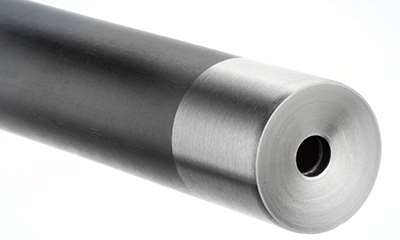
The 0.920"-wide, 19"-long sightless barrel is comprised of unidirectional graphite carbon fiber and stainless steel. The latter material is employed in critical areas, including: lining (bore), muzzle, and near the receiver, where the chamber, V-block, vent hole and gas-dispersion block are found. To protect the rifling, the barrel lining stops just shy of the muzzle’s steel cap, which features an 11-degree crown. Further, the rear of the receiver has a hole through which a rifle rod can pass (once disassembled, of course) to facilitate chamber-to-muzzle cleaning, an additional safeguard for the rifling. The barrel’s graphite/stainless steel junctions are seamless, and the combination of materials contributes to the gun’s light, 4-lb., 7-oz. heft.
The MLR22WMBW is named for the “Barracuda” thumbhole stock. Although offered since the first MLRs debuted in 1997, to date, only colored-laminate versions were available. For 2015, the company began offering the stock in American black walnut. For average-size hands, the unconventional design has a near-perfect fit and feel; the thumbhole, palm swell and flared shelf at the bottom of the pistol grip are quite comfortable and provide a rock-solid hold. Behind the pistol grip, a fair bit of wood is removed to save weight, and the comb exhibits considerable slope to align the eye with an optic. Capping the butt is a 1/4"-thick rubber recoil pad with slight tackiness. Three-and-one-half inches forward of the receiver the fore-end angles downward and continues forward without touching the barrel, therefore, much of the barrel is free-floating. The floating barrel probably improves accuracy, and definitely speeds heat dissipation during extended range sessions. Immediately forward of the magazine the stock is a wide, 2.18" in diameter. Lefties beware, the stock design is not bilateral.
For testing, we topped the Model MLR22WMBW with a Weaver Grand Slam 4-16X 44 mm riflescope in Weaver Grand Slam rings and shot five, five-shot groups at 100 yds. from a Caldwell 7 Rest using three different loads. Of the loads, the most accurate proved to be CCI’s 40-gr. GamePoint, which had both the smallest single group (0.53") and five-group average (0.75"); however, all three of the ammunition types provided satisfactory accuracy. During testing, the evaluation arm experienced four malfunctions, all of which occurred with the Hornady load. There was one failure to feed and three “stovepipes” (half ejection).
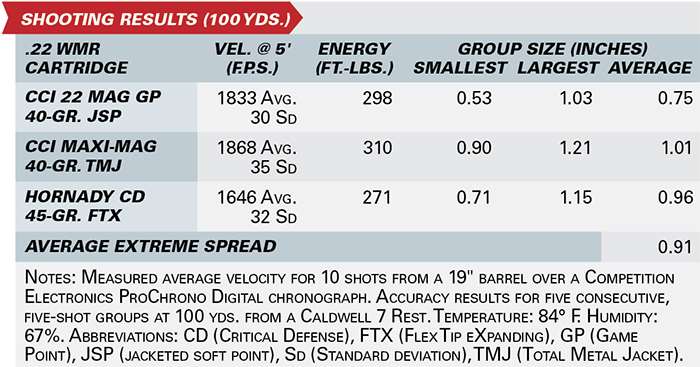
Testing in the direct sunlight during a hot summer day, the graphite/stainless steel barrel heated surprisingly quickly, though the cooling time was less than with an all-metal barrel. Still, vertical stringing occurred as the barrel heated. Additionally, the evaluators liked the Barracuda stock design; specifically, when cheekweld was established, the eye automatically aligned with the scope, and the pistol grip is dimensionally correct for maximum control and comfort. Lastly, that the rifle uses Ruger’s rotary magazine is a bonus.
The Model MLR22WMBW is not for everyone; hunters who pursue small game and predators in areas requiring lead-free ammunition will need to look elsewhere, as the rifle cannot safely and reliably use lightweight leadless loads. But for shooters and hunters who pine for a .22 WMR-chambered semi-automatic rifle to use in places without such restrictions, the MLR Barracuda is certainly worth a look. It offers a unique blend of traditional and high-tech features with good performance.

